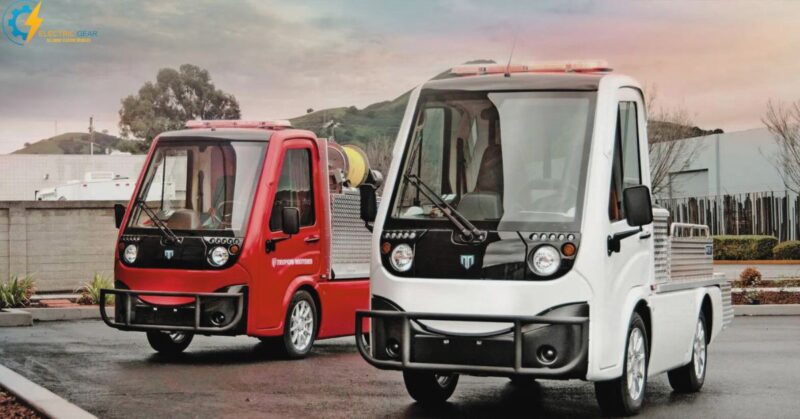Difference Between Bolt EV and EUV: Both Chevy models have more similarities than contradicting features. The Bolt EUV crossover is more user-friendly, likable, and bigger than an EV hatchback.
Bolt EUV has more options, particularly in its premier trim, like fast charging and single-pedal driving. Although it’s 6″ larger than the Bolt EV, and despite being bigger, it doesn’t have roomy cargo space.
Bolt EV vs Bolt EUV
world, Bolt EV came as an innovator of cheap, affordable electric cars covering more miles than any other EV in the same price range. It became popular due to its mileage, cost, spacious interior, and lavish design.
Bolt EUV is designed with General Motors’ autonomous driving technology of Super Cruise hands-free driving on the U.S. and Canada’s compatible roads of over 200,000 miles.
The system is only functional where the separator differs from the incoming traffic, and the feature’s functionality is seen by a green bar on the top of the steering; the bar turns blue in the manual steering mode.
The regular model of the Bolt EV doesn’t contain this feature, and that’s a strong point in EUV’s favor.
Super Cruise feature EUV model has put it on par with the much more costly Tesla Model having Autopilot technology.
Difference Between Chevrolet Bolt EV vs. EUV
Although both EVs share the 65kWh battery packs, the Bolt EV, in contrast, travels a longer distance on the same charge and also charges quicker than EUV.
The Bolt EV goes further and charges faster. Although the range difference is slighter to 12 miles, only 247 for EUV and 259 for Bolt EV, this minor range difference can’t be overruled when going to charging queues.
Bolt EUVs and EVs almost receive a mile range per hour of charging on a level 1—120-v household charger.
Charging via Level 2, the 220-v charger takes seven hours to charge fully. While charging by a DC fast charger, the Bolt EV performs slightly better and charges 100 miles in 30 minutes as against 95 miles in the same time for an EUV.
The Bolt EV Can Haul More Stuff
Although the EUV is larger by 6.3″ wider by 0.2″, and taller by 0.1″ than a Bolt EV, its cargo room is slightly undersized.
Below are the cargo specifications of both EVs:

Bolt EUV Cargo Volume
- 16.3 cubic feet: in the back of the second row
- 56.9 cubic feet: after folding the second row
Bolt EV Cargo Volume
- 16.6 cubic feet: in the back of the second row
- 57.0 cubic feet: after folding the second row
Verdict
Although the Bolt EUV is bigger, more than its cargo room is needed to the satisfying level. If seen from a cargo perspective, both EVs offer almost the same size of overall space. However, the Bolt EV comes with a bit more cargo space, while the EUV provides three inches of extra legroom.
The Bolt EUV is Bigger and Nicer than the EV
As mentioned earlier, the Premier trim is more friendly and offers more features than the Bolt EV. One–pedal driving, leather, and fast charging are among the most glaring features. It holds almost all the interior dimensions and the same stuff that is nearly identical.
Its sleeker Redline model gives a sporty look and is mainly liked by other EVs.
Bolt EV vs. EUV Price and Availability
It looks surprised to see the all-electric Bolt EUV price at $31,995 and Bolt EV for $37,495
A new Chevy Bolt EUV starts from $40,198 MSPR, while the starting price for a Bolt EV is $38,198 MSPR. The prices will be even lower in the pre-owned market, to $39,000 for EUV and $37,000 for Bolt EV.
Bolt EUV is the cheapest of all available EVs, and its price is even less than the previous year because GM cut some of the tax credits and, thus, lowered the prices of its EVs. Now the prices are lower by $6,300 for 2024.
Bolt EUV price is now fixed at $28,195; for Premier top line, it’s $ 32,695 for the year 2024. Bolt EV price now starts at $26,595 for the 1LT model and $29,795 for the 2LT.
Bolt EV vs. Bolt EUV: Range
While considering the same features, battery pack, EV size, and powertrain, one would expect the same range for both vehicles. With a 200-horsepower electric motor, EUV comes with a slightly lower mileage of 247, and the Bolt EV’s range is 12 miles more with 259 miles.
Bolt EV vs. Bolt EUV: Charging
If charging from a 120-v home charger, both models —bolt EUV and EV would get almost 3.7 miles (5.95 km) of range per hour charging.
The range will be maximized for EUV to 36.66 miles (58.99 km ) and Bolt EV 38.5 miles (61.95 km) per hour if charged using a 240-v, 48-ampere, Level 2 charger, and it will take seven hours to charge the battery fully. The same will be charged for 10 hours if a 240-v, 32-ampere charger is used.

The range difference slightly increases as we move towards charging by a DC fast charger, and one-hour charging will produce 95 (152.9 km ) and 99.4 miles (159.9 km ) of range for EUV and EV, respectively.
Bolt EV vs. Bolt EUV: Dimensions
Dimensions are another area of difference between Bolt EUV and EV. If we talk about the Chevy Bolt 2024 EUV, its length is 169.5″, height is 63.6″, and width is 69.7″ wide.
The passenger volume of EUV is 97 cubic feet, with 16 cubic feet left for the cargo room right behind the back seats. SUV crossover Bolt EUV has a bit more passenger volume than the Bolt EV.
The Bolt EV, in comparison, is 163.2″ long, 69.5″wide, and 63.4″ tall. The passenger space of the Bolt EV is around 93.9 cubic feet, and the cargo space is 16.6 cubic feet behind the back seats like the EUV. It contains a bit more cargo space than EUV.
Bolt EV Vs. EUV: Performance
200 horsepower electric powered motor is used in Chevy EV, which might be the strongest for a hatchback. 266 pound-feet torque provides enough power to jump-start from the beginning.
The same powertrain, battery pack, and electric motor are also used in crossover EUVs, and they almost come with the same performance levels.
Bolt EUV vs. Bolt EV: Design
The difference in exterior designs of both EVs is so minimal that no one can find it at first. The same style cues and design details are used in Bolt EUV and EV. However, due to the bigger crossover EUV, side panels are not used in it.

The same is true with the interior of both EVs, and one will find the interior features of two EVs identical.
Verdict
If looked at from exterior, and interior viewpoints, there are more similarities than differences. Appearance is the most significant difference between Bolt EUV and EV as the former is bigger, has a more rugged front style, and looks like an SUV crossover.
The Bolt EV is a bit shorter in size and looks more like a hatchback. So, except for the smaller size of the hatchback EV, most outlook features are identical.
Chevy Bolt EUV vs. Bolt EV Powertrain
Bolt EUV and EV virtually use the same powertrain with a 200-horsepower electric motor, producing 266 pounds of torque. Battery packs are also identical, with 65 kWh of capacity.

Due to the same battery packs, motor, and powertrain, Bolt EUV and EV also travel almost the same distance, with 12 miles additional in favor of Bolt EV.
One-pedal driving is the hallmark of both EVs that stop the vehicle even when no one touches the brake pedal.
Similarities
Virtually the differences are hard to find between both the EVs. The powertrain, battery pack, and motor—generating 200 hp and torque of 266 pound-feet—are ideally the identical features of Bolt EUV and EV. The single battery charging range is also almost the same—259 miles (416.82 km).
If you choose either of the vehicles from Bolt EUV and EV—each vehicle uses the standard safety assistance package, is compatible to be charged with a DC fast charger, and gets 95 miles (152.8 km) of range in a short while of 30 minutes. Refined LED head beams and taillights are used with a 10.2″ mid display.
Specifications of Chevy Bolt EV and Chevy Bolt EUV
| 2022 Chevy Bolt EV | 2022 Chevy Bolt EUV | |
|---|---|---|
| 259 miles | Range | 247 miles |
| 200 | Horsepower | 200 |
| FWD | Drivetrain | FWD |
| 16.6 cubic-feet | Cargo volume | 16.3 cubic-feet |
| 6.4 second | Acceleration 0-60 miles | 7.0 second |
| 115 | MPGe | 115 |
| 5 | Seating capacity | 5 |
| No | Underfloor storage | Yes |
| 63.43″ | Height | 63.6″ |
| 69.5″ | Width | 69.7″ |
| 163.2″ | Length | 169″ |
| No | Supercruise | Yes |
| 266 lb-feet | Torque | 266 lb-feet |
| 100 miles | DC fast charging time in 30 minutes | 95 miles |
| $37,495 | Price | $31,995 |
| 3.7 miles | Level 1, charging per hour | 3.7 miles |
| 93.9 cubic feet | Passenger volume | 97 cubic feet |
| 65 kWh Lithium-ion battery | Battery | 65 kWh lithium-ion battery |
| 5.5 inches | Ground clearance | 5.5 inches |
Conclusion
It’s clear that both the Chevy Bolt EV and Bolt EUV have a lot of great features and options, but each has its strengths. The Bolt EV stands out because it has a slightly longer range and charges faster, making it a great choice for people who want to save money and have more room for cargo.
While the Bolt EUV has more space for passengers, more advanced technology like the Super Cruise, and a style more like an SUV, it appeals to drivers who want a more comfortable and tech-savvy ride.
In the end, the choice between the Bolt EV and Bolt EUV will come down to personal wants and preferences, such as range and cargo space or comfort and cutting-edge features.
Chevrolet is committed to making cheap, high-performance electric cars, and both models show this. Either choice is a good step toward a greener future.

Imran is an experienced content writer who crafts engaging and informative articles for a variety of industries. With a keen eye for detail and a passion for storytelling, Imran delivers high-quality content that resonates with readers. Whether he’s writing blog posts, social media content, or website copy, Imran is committed to delivering compelling content that drives results.







